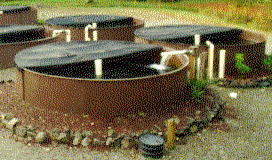
Boats |

Paints |

Helmets |
Before we begin with the demolition of composites and their many forms, we must first understand what, when, where, and how composites are used in everyday life. For those of you not familiar with polymers (poly=many; mers=monomers or chemical repeat units) and composites (Webster's definition-made up of distinct parts or a multiphase material) please visit the University of Southern Mississippi School of Polymer Science polymer website, the Macrogalleria to gain a better understanding of polymers and composites before you launch into the realm of characterization and analysis of these materials (WARNING-some destruction included).
Composites are literally everywhere!! Below are shown just a few
of the major products we use everyday to simply to live, move about, and
to protect ourselves that are made up of composites.

Boats |

Paints |

Helmets |

Automobiles
Composites not only can be seen in applications such as above, but are present in many "behind the scene places". Fuel tanks, pipes, sporting goods, and numerous other products involve composites in their construction. Some key characteristics of composites that make them so useful are:
1. Specific strength-This
is simply the rigidity or hardness of a material with regard to its weight.
For example,
a number of composites such as fiberglass share comparable impact resistance
(bangability) with steel and
titanium at a fraction of the weight employed.
2. Expense-Many composites can be manufactured with less cost than their traditional metal counterparts.
3. Application-Because
composites are composed of 2 or more "phases", they can be formulated to
meet the needs of a
specific application with considerable ease.
4. Processability-As
most of you know, metal processing requires high amounts of thermal energy
(heat). Plastics and plastic
based composites require less heat to mold or process the products.
There is a constant desire to produce
composites which can be processed at low temperatures but when cured or
set-up (paint drying or a mold
cooling), they are very impact resistant and very heat resistant or fire
retardant.
Without engaging in a thorough description of what polymer composites are molecularly and chemically, the basic premises for a composite is 2 or more components comprised together on some level of order or mixing. The general purpose for having multiple components is to either soften or toughen a hard material or harden or strengthen a soft material. Below are 4 general classifications of composites:
1. Blends-As
one would expect, a blend is a mixture of 2 or more substances. These
materials can be polymers, metals, or
other components. Typically, there is no chemical bonding between
the two components, but intermolecular forces
do occur. This blend can be homogenous [mixed to the extent
in which the original components can not be
distinguished from one other] in different dimensions of the mixture.
Some blends are mixed on the order of 1
millionth of a meter (molecular) while some are just homogenous to the
naked eye. When adequate blending
occurs, the properties of the individual components can be seen on the
whole much like the marriage of 2
opposite people, both offer the other various traits. Pictured below
is an excellent example of a common blend,
steel, which is a combination of iron and carbon. For a better analysis
of blends, please check out Blends.

2. IPN's-Inter-penetrating
networks is an area of composites which can produce synergistic properties
(the material
produced has better characteristics than the separate components combined).
Most composites do not display
properties that exceed the additive properties of the components.
A tradition definition of an IPN conveys a
co-continuous phase morphology. Recently, however, several amendments
have been added to the original
definition. For a better understanding of IPN's, please visit the
following website: IPN's.
3. Fiber Composites-Composites
which contain fibers in the matrix material are used for many applications.
A common
fiber containing composite is fiberglass, which has an epoxy resin (polyester
polymer) matrix and
glass fiber fillers for reinforcement. The glass fibers strengthen
the resin and make it more
impact resistant. Many boat hulls are made of fiberglass and must
with stand the constant
beating of waves and other hard objects in water such as wood and rock.
Shown below are
fiberglass fish holding tanks. For an detailed study of fibers, check
out this site: Fibers

4. Nanocomposites-Composites
in which the fiber reinforcement is on the extremely small "nano scale"
(1*10-9 meters) are
known as nanocomposites. Clay particles is a common nano-component
in composites and it offers
a selection of applications not seen in other "large" fiber composites.
For a detailed account of
nanocomposites, please look at Nanocomposites.
Now that we have looked at some applications and characteristics of composites, let's begin the "break down" of materials in an introduction to characterization and analysis of composites.
Click here for next step to destruction.
Or test you knowledge with this NEAT Composites
Quiz